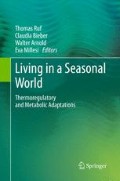Abstract
We investigated the impact of age on patterns of hibernation in the edible dormouse. Multi-model inference showed that changes in hibernation duration, measured in 34 dormice implanted with temperature loggers, were best explained by effects of age. On average, each year of life shortened the hibernation duration by 15.17 days. While we did not observe significant changes in the timing of hibernation onset, every additional year of life led to an earlier mean termination of hibernation by 11.33 days. Since age did not influence torpor bout duration, arousal frequency or the duration of inter-bout euthermia, we conclude that the observed effects are not caused by ageing processes (e.g. physiological incapability). We discuss the observed age effects in relation to the unique life-history pattern in this species. Dormice invest into reproduction only in years with mast seeding. Thus, it may take some years until conditions are suitable for reproduction. While long hibernation periods predictably increase survival, an early termination of hibernation may provide an advantage in the establishment of high quality territories, which in turn may increase fitness. With increasing age, dormice are likely to favour investment into reproduction instead of maximising survival probability.
Access this chapter
Tax calculation will be finalised at checkout
Purchases are for personal use only
References
Akaike H (1973) Information theory as an extension of the maximum likelihood principle. In: Petrov BN, Csádki F (eds) Second international symposium on information theory. Akadémiai Kiadó (Budapest), Tsahkadsor, pp 267–281
Barnes BM, Kretzmann M, Licht P, Zucker I (1986) The influence of hibernation on testis growth and spermatogenesis in the golden-mantled ground squirrel, Spermophilus lateralis. Biol Reprod 35:1289–1297
Barton K (2011) MuMIn: Multi-model inference. R package version 1.0.0. http://CRAN.R-project.org/package=MuMIn
Bates D, Maechler M, Bolker B (2011) lme4: Linear mixed-effects models using S4 classes. R package version 0.999375-39. http://CRAN.R-project.org/package=lme4
Bieber C (1998) Population dynamics, sexual activity, and reproduction failure in the fat dormouse (Myoxus glis). J Zool Lond 244:223–229
Bieber C, Ruf T (2004) Seasonal timing of reproduction and hibernation in the edible dormouse (Glis glis). In: Barnes BM, Carey HV (eds) Life in the cold: evolution, mechanism, adaptation, and application. Twelfth international hibernation symposium. Institute of Arctic Biology, University of Alaska, Fairbanks, pp 113–125
Bieber C, Ruf T (2009a) Habitat differences affect life history tactics of a pulsed resource consumer, the edible dormouse (Glis glis). Popul Ecol 51:481–492
Bieber C, Ruf T (2009b) Summer dormancy in edible dormice (Glis glis) without energetic constraints. Naturwissenschaften 96:165–171
Burnham KP, Anderson DR (2002) Model selection and multimodel inference, 2nd edn. Springer, New York
Fietz J, Pflug M, Schlund W, Tataruch F (2005) Influences of the feeding ecology on body mass and possible implications for reproduction in the edible dormouse (Glis glis). J Comp Physiol 175:45–55
Fietz J, Schlund W, Dausmann KH, Regelmann M, Heldmaier G (2004) Energetic constraints on sexual activity in the male edible dormouse (Glis glis). Oecologia 138:202–209
Heller CG, Clermont Y (1963) Spermatogenesis in man: an estimate of its duration. Science 140:184–186
Lebl K, Kürbisch K, Bieber C, Ruf T (2010) Energy or information? The role of seed availability for reproductive decisions in edible dormice. J Comp Physiol 180:447–456
Lebl K et al (2011a) Survival rates in a small hibernator, the edible dormouse: a comparison across Europe. Ecography 34:683–692
Lebl K, Rotter B, Kürbisch K, Bieber C, Ruf T (2011b) Local environmental factors affect reproductive investment in female edible dormice. J Mammal 92:926–933
Pilastro A, Tavecchia G, Marin G (2003) Long living and reproduction skipping in the fat dormouse. Ecology 84:1784–1792
R Development Core Team (2011) R: a language and environment for statistical computing. R Foundation for Statistical Computing, Vienna. Version 2.13.1. http://www.R-project.org
Ruf T, Fietz J, Schlund W, Bieber C (2006) High survival in poor years: life history tactics adapted to mast seeding in the edible dormouse. Ecology 87:372–381
Schlund W, Scharfe F, Ganzhorn JU (2002) Long-term comparison of food availability and reproduction in the edible dormouse (Glis glis). Mammal Biol 67:219–223
Turbill C, Bieber C, Ruf T (2011) Hibernation is associated with increased survival and the evolution of slow life histories among mammals. Proc R Soc B Biol Sci 278:3355–3363
Vietinghoff-Riesch AFv (1960) Der Siebenschläfer. In: Müller-Using D (ed) Monographien der Wildsäugetiere. Gustav Fischer Verlag, Jena, pp 1–196
Acknowledgments
We thank P. Steiger, K. Außerlechner, C. Skerget for their help with data collection and W. Zenker, F. Balfanz, C. Beiglböck, C. Walzer for implantation of iButtons. We declare that all experiments in this study comply with the current laws of Austria in which they were performed. We thank F. Knauer for his support with the package MuMIn. This project was supported by the city of Vienna, the province of Lower Austria and the Austrian Science Fund (FWF, Project P20534-B17).
Author information
Authors and Affiliations
Corresponding author
Editor information
Editors and Affiliations
Rights and permissions
Copyright information
© 2012 Springer-Verlag Berlin Heidelberg
About this chapter
Cite this chapter
Bieber, C., Ruf, T. (2012). Does Age Matter? Effects of Age on Hibernation Patterns in Edible Dormice (Glis glis). In: Ruf, T., Bieber, C., Arnold, W., Millesi, E. (eds) Living in a Seasonal World. Springer, Berlin, Heidelberg. https://doi.org/10.1007/978-3-642-28678-0_12
Download citation
DOI: https://doi.org/10.1007/978-3-642-28678-0_12
Published:
Publisher Name: Springer, Berlin, Heidelberg
Print ISBN: 978-3-642-28677-3
Online ISBN: 978-3-642-28678-0
eBook Packages: Biomedical and Life SciencesBiomedical and Life Sciences (R0)

